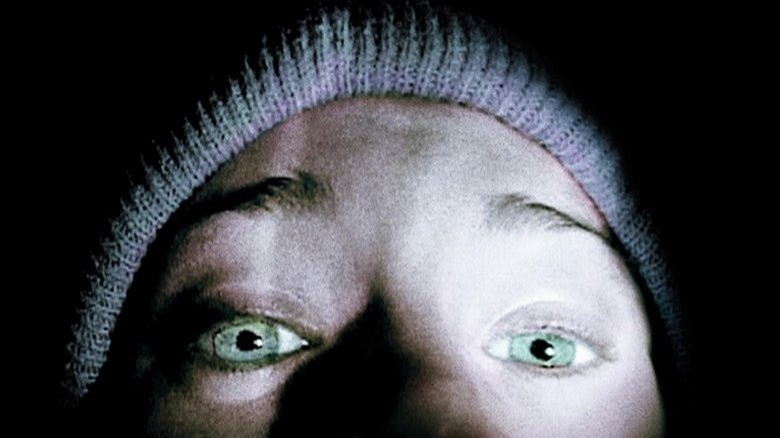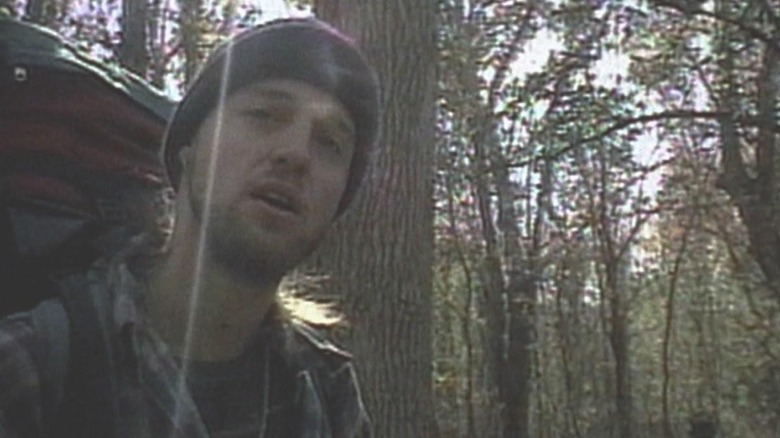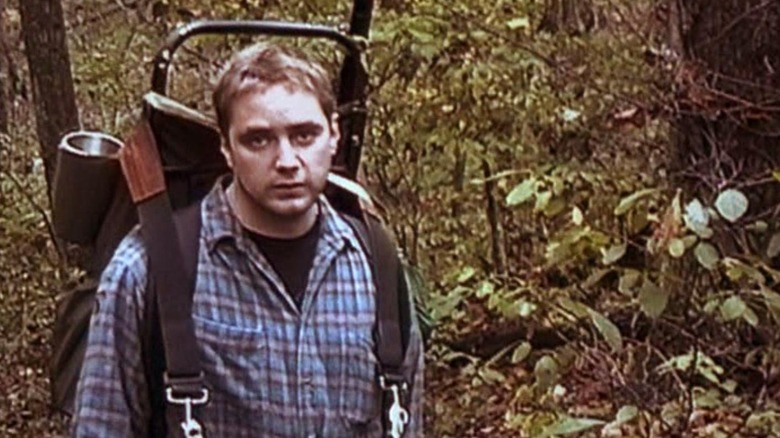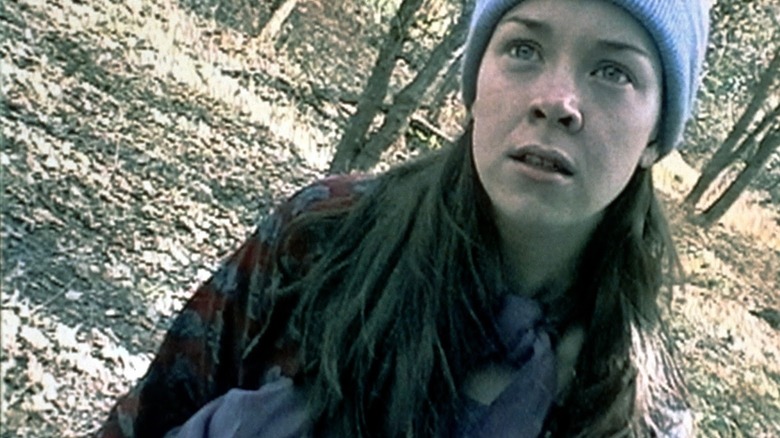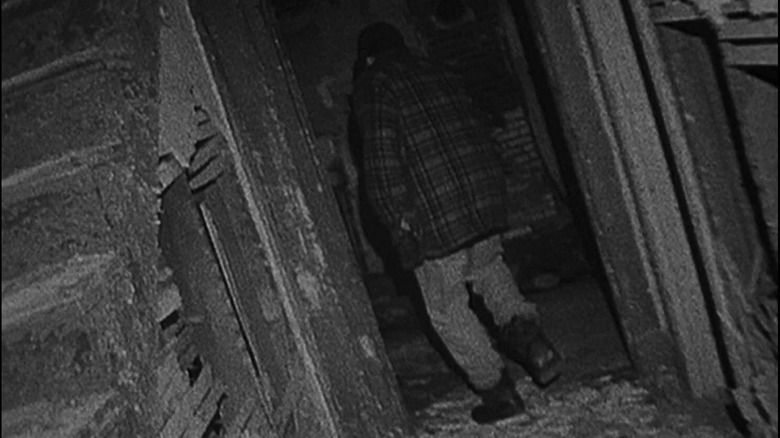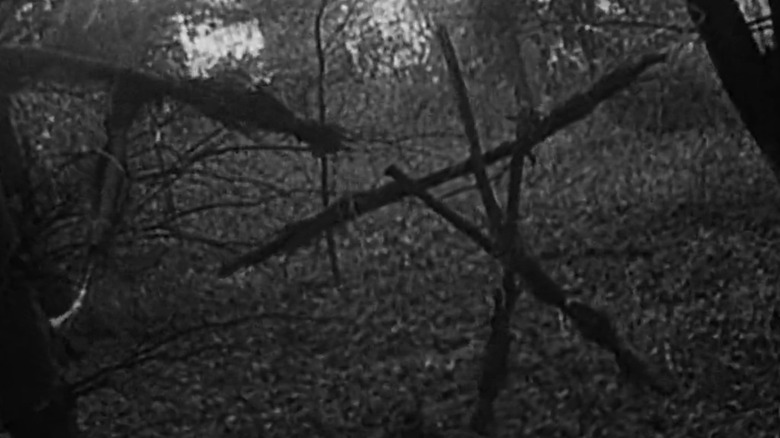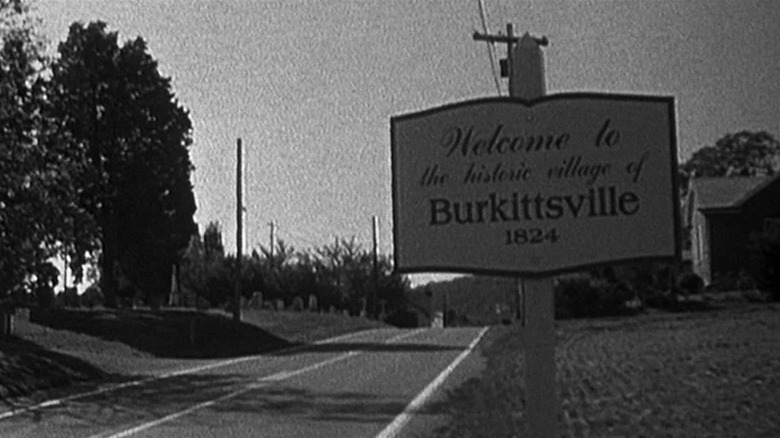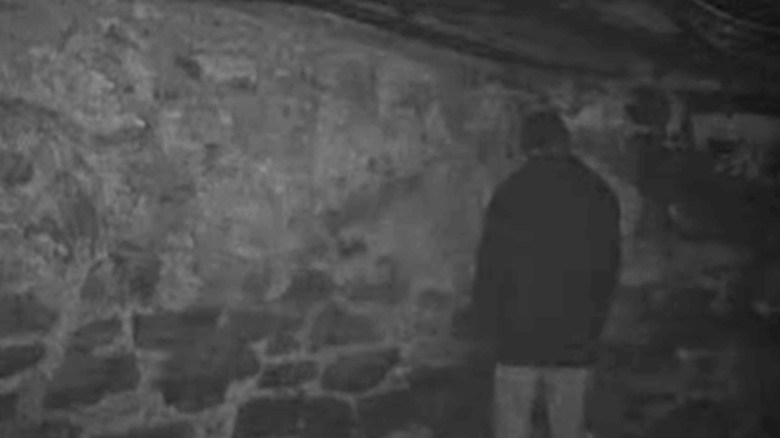The Blair Witch Project Ending Explained: As Maddening And Mysterious As It Was 20 Years Ago
The insidious ending of "The Blair Witch Project" has boggled my mind and the minds of many others for an incredible 20 years. As the story goes, attendees at Sundance 1999 didn't know if they were watching a fictional account or a tried and true documentary when Daniel Myrick and Eduardo Sánchez's masterpiece screened — and even now, in the age of the internet and the ability to debunk information at the stroke of our fingertips, it still packs just as much of a punch. Even more famously, the film's creators made an incredibly convincing companion mockumentary chronicling the legend of the Blair Witch prior to their world premiere, which really upped the ante when it came to the scares and the possible realities of the terrifying prospects the film asks the audience to ponder. After all, what we concoct in our heads is almost always scarier than anything we may be shown, which, ultimately, is the name of the game with this iconic ending.
Remind me how The Blair Witch Project ends again?
Glad you asked, but sort of wondering how you could possibly forget! After Josh (Joshua Leonard), one of the three college kids who set out to document the Blair Witch in her natural habitat, goes missing in the Black Hills forest of Burkitsville, Maryland, his cohorts Heather (Heather Donahue) and Mike (Michael C. Williams) start to panic looking for him. When night falls, they hear the sound of his screams, which forces them to attempt to save him. In the midst of their efforts, they discover a rundown house and enter it.
With two cameras, Heather and Mike search the disgusting, dilapidated house—which is covered in bloody handprints—and end up separated. Mike ends up in the basement of the house, but only manages to look around for a few seconds before something or someone off-camera knocks him out.
After a few seconds, we switch to Heather's camera as we hear her screaming for her friend. The camera seemingly glides through one of the house's hallways and down the stairs into the basement—and as it does, Heather's screams grow closer. The camera slowly pans to the corner of the room, where Mike is standing tucked into the corner as Heather screams his name. Seconds later, she is knocked out herself and the camera falls to the ground along with her. The footage lingers for several seconds on a choppy image of the basement floor before the credits roll.
So what actually happened in the ending?
There are theories abound regarding the true nature of the "Blair Witch" ending, but there are two that seem to be the most plausible when you really think about it. But before we can talk theories, we need a refresher on the legend of Rustin Parr. Allow me to explain.
In the beginning of the film, Heather, Mike, and Josh interview several Burtkitsville locals about the Blair Witch and many of them discuss a former resident named Rustin Parr. In the fall and winter of 1940, several children from the town went missing around the same time. Rustin, who lived in a secluded area of the town on a hill, came into the center of town one day following the disappearances and claimed his work was "finished." Though they were unsure what he meant by that at the time, the police later searched his home and found the bodies of seven kids.
Rustin would, admittedly, take the children down to his basement in pairs, where he would force one of them to face into the corner while he killed the other. He would then kill the second child. In court, he claimed he couldn't stand being watched during the killings, which is why he devised the sadistic system.
OK, really though, what actually happened?
Now that we have that covered, let's get to the theories. The first theory asserts that after Mike is knocked out in the basement, the perspective we change to is not Heather's, but the Blair Witch's herself. We don't see a moment where Heather loses her own camera, but it isn't hard to justify the choice on the filmmakers' part. She could've easily dropped it in the chaos. Either way, Mike certainly lost his, which would explain how the Blair Witch would've been able to film the duo's final moments. Another element of the ending that supports this theory is the fact that the mysterious second wielder of Heather's camera is freakishly tall. When the camera pans down the basement steps, it almost hits the ceiling, which means the person or thing carrying it has some height on them, or might just be gliding around like a witch.
The second theory—the still plausible but not the numero uno theory—supposes that the perspective change is actually from Heather to Josh, her and Mike's missing friend. This idea stems from the fact that Rustin Parr also claimed that a woman instructed him to perform his killings, a woman speculated to be the Blair Witch. This concept also supposes that Josh's screams on the night Heather and Mike find the Rustin Parr house were a ploy to get the director and the sound guy into the house—meaning he was under the Blair Witch's spell like Rustin Parr was. The theory even holds water when it goes back further in the timeline. The night after Josh disappears, Heather and Mike hear his agonizing cries far off in the distance—or at least someone they're convinced is Josh—and the next morning, they find a bundle of sticks held together with a ripped piece of his flannel shirt. When Heather opens the bundle, she finds a pile of bloody teeth inside, which one could gather belong to Josh. Makes sense as to why they heard him screaming in the distance the night before, and if you believe that the Blair Witch's power of manipulation is as strong as legend claims, it's safe to assume he pulled out his own teeth at her behest.
Honestly, both theories track. The beauty of this film is that the filmmakers never give us quite enough to be sure of exactly what happens, just enough unsettling camera movement, horrifying set design, and petrified performances to absolutely terrify us until the end of time.
Not convinced? Have some more theories
Naturally, there are a few other theories that have been floated in the past, but personally, I don't think they can account for the full picture of what's going on in the way that the two most widely accepted theories do. That said, it's always fun to think outside the box a bit—and they aren't totally off-base guesses, either.
The first theory supposes that there's a time loop at play within the Black Hills forest. Technically, this could explain why Parr's house—which was supposedly torn down after his conviction—was still standing in the woods all those years later. That's really the only bit of evidence to support that claim, which makes this theory almost an add-on theory in the sense that it could be true while another theory is also true at the same time. It's even a concept that the 2016 sequel film "Blair Witch" plays with, so I guess you could say it's part of the lore by default now.
Even more theories
Another theory asserts that Burkitsville locals were the actual killers. After all, those creepy stick figure hangings could have been placed on the trees by nearby residents under the convenient cover of the forest being haunted. Plus, during one scene, Mike mentions the film "Deliverance," in which a group of outsiders are targeted and hunted by unwelcoming locals. It could be a tell-tale hint, a red herring, or just a coincidence, but there isn't much proof beyond Mike's aside.
One of the more popular lesser theories is that Mike and Josh are the killers, and they were in on it together. It's kind of a bold theory, considering we don't ever really get any inkling on what they could have against Heather in a way that would make them compelled to do something so sinister to her. Mike does destroy the group's map in a moment of delirious rage, but considering the kind of person his character is, it seems like it was probably just that: a moment of terror and confusion, especially considering how Mike is the first character to start to panic when they start feeling lost.
The last of the lesser theories is one of the least likely, but it is certainly a fun one to think about. This theory supposes that the kids Parr killed were behind everything. One of the scariest scenes in the film is when the group finds their tent surrounded by what sounds like small children, who then start to shake the tent violently before the trio takes off into the dark forest like bats out of hell. That's the only time the children are actually seen or heard in any capacity in the movie, so while it's a fun theory to conceptualize—when revenge is warranted, it's usually a pretty compelling idea, and this would be a pretty unexpected way to utilize that trope—it doesn't exactly come together in the greater context of the entire film and the lore.
Don't forget the alternate endings
Interestingly enough, the film has a whopping three alternate endings, and each one speaks to how special the final ending actually was. The first of the alt finales features Mike being crucified on one of the stick figure hangings instead of facing the corner in Parr's basement, and it is perhaps the most well-known of the three. While it certainly ramps up the gore factor with an ending like this, it just doesn't fit the overall execution of the film, which builds its scares on the unseen rather than what is tangible to us. This ending would have been in your face, but devoid of much meaning.
The second alternate ending sees Mike hanged in the basement rather than waiting in the corner for his own punishment to be carried out. Again, this is a more violent approach, but does nothing for the story, nor does it tie things together at the end. In fact, the general consensus is that these two alternate endings don't actually bring any clarity or closure for the audience. The final alternate ending flips the script a bit and features Mike facing Heather in the basement, staring her down menacingly. This ending actually does have an effect on the film's plot in the viewer's eyes, because it allows them to assume that Mike is somehow involved in what went on leading up to this point, and that he plans to attack Heather in some way. It fundamentally changes the film's conclusion, because it insinuates that the source of all this horror has been human, not supernatural. Naturally, it just doesn't suit the story, and ultimately none of these endings ended up making it anywhere but the special features section.
Does the ending still hold up, though?
It's hard to understate the utter star power of the film's true ending and how it still holds its own in the present. We don't speak of the utterly abysmal sequel "The Blair Witch Project 2: Book of Shadows," but the newer, more honorable 2016 installment spent its 89-minute runtime making homage after homage to the original film. In fact, the movie's entire premise hinges on one of the 1999 chiller's final moments.
In director Adam Wingard's continuation, lead character James is Heather's younger brother, who becomes obsessed with finding her in the Black Hills forest after seeing a clip of what appears to be lost footage of Heather's potential last moments in the Rustin Parr house in 1999. He enlists three of his friends to join him in setting out to find her—including one friend who is, shocker, a documentary filmmaker—and they end up in a terrifying mess that harkens back to the film that started it all.
Though that film takes artistic liberties and creates new conventions for the "Blair Witch" universe to play in, it is clear that it is a direct continuation and heavily influenced by the maddening magic of the original's breathtaking ending. During an interview, Simon Barrett, who wrote the script for the 2016 picture, told me (in an aside that never got published) that he specifically wanted to write a "Blair Witch" movie for the die-hards, the people who knew and respected the lore. No matter how you feel about the movie, it's clear he succeeded.
From a filmmaking perspective, I firmly believe the original Blair Witch Project ending will never be topped, especially not in the found footage subgenre. The confusing perspectives, the anxiety-inducing camera work, the absolutely manic acting, the sublime set design. I could go on and on, but there were many elements that came together to make the perfect alchemical potion that is this ending. I'm just glad few people deny its terrifying staying power.
